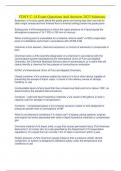FDNY C -14 Exam Questions And Answers 2023 Solutions Basement ✔✔a story partly below the grade plane and having less than one -half its clear height (measured from finished floor to finished ceiling) below the grade pl ane Boiling point ✔✔the temperature at which the vapor pressure of a liquid equals the atmospheric pressure of 14.7 PSI or 760 mm of mercury. When a boiling point is unavailable for a material, what is used? ✔✔20% evaporated point of a distillation perfo rmed in accordance with ASTM D 86 Chemical ✔✔an element, chemical compound, or mixture of elements or compounds or both Chemical name ✔✔the scientific designation of a chemical in accordance with the nomenclature system developed by the International Uni on of Pure and Applied Chemistry, the Chemical Abstracts Service rules of nomenclature, or a name that will clearly identify a chemical for the purpose of conducting an evaluation IUPAC ✔✔International Union of Pure and Applied Chemistry Closed container ✔✔a container sealed by means of a lid or other device capable of preventing the escape of liquid, vapor, or dusts in the ordinary course of storage, handling, or use Combustable liquid ✔✔any liquid that has a closed -cup flash point at or above 100F, as determined by the standard test procedures Container - solid and liquid hazardous materials ✔✔a vessel of 60 gallons or less in capacity used for storage or transportation. Container - compressed gases ✔✔a container pressure vessel or tank designed for pressures greater than on atmosphere at 68F What is not deemed a containers if in active use? ✔✔pipes, piping systems, engines and engine fuel tanks associated with solid or liquid hazardous materials or compressed gas Corrosive material ✔✔a liquid, solid, or gas that causes permanent injury ("full thickness destruction") to human skin at a rate specified by the Department of Transportation regulations. Or a liquid that can corrode 1/4in of steel or aluminum within a yea r Design pressure ✔✔the maximum gauge pressure that a pressure vessel, device, component, or system is designed to withstand safely under the temperature and conditions of use Dispensing ✔✔the pouring or transferring by other means of any material from a container, tank, or similar vessel, which would release dusts, fumes, mists, vapors, or gases to the atmosphere, unless such release is prevented by a device, equipment, or system designed for that purpose Educational laboratory unit ✔✔a laboratory unit that is used for educational purposes for students through the twelfth grade Excess flow control ✔✔a fail -safe system or other approved device, equipment or system designed to shut off flow caused by a rupture in a pressurized piping system Exhausted enc losure ✔✔a device, typically consisting of a hood equipped with a fan that serves to capture and exhaust fumes, mist, vapors, and gases generated at a workstation or other local environment. Does not include a room provided with general ventilation Explos ion ✔✔an effect produced by the sudden violent expansion of gases, whether or not accompanied by a shock wave or disruption, of enclosing materials Explosions include the effects of the following sources: ✔✔1. Chemical changes such as rapid oxidation, def lagration or detonation, decomposition of molecules, and runaway polymerization 2. Physical changes such as pressure tank ruptures 3. Atomic changes (nuclear fission or fusion) Face velocity ✔✔the rate of flow or velocity of air moving into the chemic al fume hood entrance or face, as measure at the plane of the chemical fume hood face Fire separation ✔✔a horizontal or vertical fire resistance -rated assembly of materials that have protected openings and are designed to restrict the spread of fire Flam mable gas ✔✔any substance that exists in the gaseous state at normal atmospheric temperature and pressure and is capable Flammable liquid ✔✔any liquid that has a closed -cup flash point below 100F, as determined by the standard test procedures Flammable solid ✔✔A solid, other than a blasting agent or other explosive, whether in elemental or alloy form, that is capable of causing a fire through friction, absorption of moisture, spontaneous chemical change, or heat retained from manufacturing or processing, or which has an ignition temperature below 212F or which burns so vigorously and persistently when ignited as to create a serious hazard




